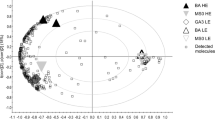Abstract
Withania somnifera (L.) Dunal synthesizes large array of pharmacologically active secondary metabolites known as withanolides. It has been extensively investigated in terms of chemistry and bioactivity profiling. However, there exists fragmentary information about the dynamics of withanolide biosynthesis at different phenophases in concert with the expression analysis of key pathway genes. In the present study, two morpho-chemovariants of W. somnifera were harvested at five developmental stages, dissected into leaf and root tissues and assayed for three major withanolides viz. withanolide-A (WS-1), withanone (WS-2) and withaferin A (WS-3) content using high performance liquid chromatography. The present investigation also analyzed the expression pattern of five withanolide biosynthetic pathway genes namely squalene synthase, squalene epoxidase, cycloartenol synthase, cytochrome P450 reductase 1, cytochrome P450 reductase 2 to corroborate with the metabolite flux at different developmental stages. The relative transcript profiles of identified genes at various ontogenetic stages illustrated significant variation in leaf and root tissues and were largely concurrent with the alteration in withanolide pool. Comparatively, the concentrations of withanolide A, withanone and withaferin A along with expression levels of all the five genes were appreciably higher in the leaves than in roots. Relative dynamics in terms of quantitative and qualitative profiles of withanolides in leaf and root tissues revealed least correspondence between the pattern of accumulation, possibly indicting towards de novo tissue-specific biosynthesis.



Similar content being viewed by others
References
Tuli R, Sangwan RS (2009) Ashwagandha (Withania somnifera)—a model Indian medicinal plant. Council of Scientific and Industrial Research (CSIR), New Delhi
Lattoo SK, Dhar RS, Khan S, Bamotra S, Dhar AK (2007) Temporal sexual maturation and incremental stamina movement encourages mixed mating in Withania somnifera—an insurance for reproductive success. Curr Sci 92:1390–1399
Dhar RS, Verma V, Suri KA, Sangwan RS, Satti NK, Kumar A, Tuli R, Qazi GN (2006) Phytochemical and genetic analysis in selected chemotypes of Withania somnifera. Phytochemistry 67(20):2269–2276. doi:10.1016/j.phytochem.2006.07.014
Singh AP (1981) Chemistry and genetics of withanolides in Withania somnifera hybrids. Phytochemistry 20:2741–2748
Budhiraja RD, Sudhir S (1987) Review of biological activity of withanolides. J Sci Ind Res 46:488–491
Ray AB, Gupta M (1994) Withasteroids, a growing group of naturally occurring steroidal lactones. Fortschr Chem Org Naturst 63:102–106
Jayaprakasam B, Zhang Y, Seeram NP, Nair MG (2003) Growth inhibition of human tumor cell lines by withanolides from Withania somnifera leaves. Life Sci 74:125–132
Choudhary MI, Nawaz SA, Haq ZU, Lodhi MA, Ghayur MN, Jalil S, Riaz N, Yousuf S, Malik H, Gilani AH, Atta-ur-Rahman A-U (2005) Withanolides, a new class of natural cholinesterase inhibitors with calcium antagonistic properties. Biochem Biophys Res Commun 334:276–287
Kuboyama T, Tohda C, Komatsu K (2005) Neuritic regeneration and synaptic reconstruction induced by withanolide A. Br J Pharmacol 144:961–971
Kaileh M, Berghe WV, Heyerick A, Horion J, Piette J, Libert C, Kukeleire DD, Essaw T, Haegeman G (2007) Withaferin A strongly elicits IκB kinase β hyperphosphorylation concomitant with potent inhibition of its kinase activity. J Biol Chem 282:4253–4264
Hahm ER, Moura MB, Kelley EE, Van Houten B, Shiva S et al (2011) Withaferin A-induced apoptosis in human breast cancer cells is mediated by reactive oxygen species. PLoS One 6(8):e23354
Koduru S, Kumar R, Srinivasan S, Evers MB, Damodaran C (2010) Notch-1 inhibition by withaferin-A: a therapeutic target against colon carcinogenesis. Mol Cancer Ther 9:202–210
Mirjalili MH, Moyano E, Bonfill M, Cusido RM, Palazon J (2009) Steroidal lactones from Withania somnifera, an ancient plant for novel medicine. Molecules 14:2373–2393
Sangwan RS, Chaurasiya ND, Misra LN, Lal P, Uniyal GC, Sangwan NS, Srivastava AK, Suri KA, Qazi GN, Tuli R (2005) An improved process for isolation of withaferin-A from plant materials and products therefrom. US Patent # 7,108,870
Eldin HHN, Andersen TG, Burow M, Madsen SR, Jørgensen ME, Olsen CE, Dreyer I, Hedrich R, Geiger D, Halkier BA (2012) NRT/PTR transporters are essential for ranslocation of glucosinolate defence compounds to seeds. Nature 488:531–534. doi:10.1038/nature11285
Yang CQ, Fang X, Wu XM, Mao YB, Wang LJ, Chen XY (2012) Transcriptional regulation of plant secondary metabolism. J Integr Plant Biol 54(10):703–712
Glotter E (1991) Withanolides and related ergostane-type steroids. Nat Prod Rep 8:415–440
Sangwan RS, Chaurasiya ND, Lal P, Misra L, Tuli R, Sangwan NS (2008) Withanolide A is inherently de novo biosynthesized in roots of the medicinal plant ashwagandha (Withania somnifera). Physiol Plant 133:278–287
Tholl D, Lee S (2011) Terpene specialized metabolism in Arabidopsis thaliana. Arabidopsis Book 9:e0143
Za′rate R, Dirks C, Heijden RVD, Verpoorte R (2001) Terpenoid indole alkaloid profile changes in Catharanthus pusillus during development. Plant Sci 160:971–977
Lattoo SK, Dhar RS, Dhar AK, Sharma PR, Agarwal SG (2006) Dynamics of essential oil biosynthesis in relation to inflorescence and glandular ontogeny in Salvia sclarea. Flavour Fragr J 21:817–821. doi:10.1002/ffj.1733
Bhat WW, Lattoo SK, Razdan S, Dhar N, Rana S, Dhar RS, Khan S, Vishwakarma RA (2012) Molecular cloning, bacterial expression and promoter analysis of squalene synthase from Withania somnifera (L.) Dunal. Gene 499:25–36
Razdan S, Bhat WW, Rana S, Dhar N, Lattoo SK, Dhar RS, Vishwakarma RA (2013) Molecular characterization and promoter analysis of squalene epoxidase gene from Withania somnifera (L.) Dunal. Mol Biol Rep 40:905–916. doi:10.1007/s11033-012-2131-9
Rana S, Lattoo SK, Dhar N, Razdan S, Bhat WW, Dhar RS, Vishwakarma R (2013) NADPH-cytochrome P450 reductase: molecular cloning and functional characterization of two paralogs from Withania somnifera (L.) Dunal. PLoS one 8(2):e57068
Sabir F, Mishra S, Sangwan RS, Jadaun JS, Sangwan NS (2012) Qualitative and quantitative variations in withanolides and expression of some pathway genes during different stages of morphogenesis in Withania somnifera Dunal. Protoplasma. doi:10.1007/s00709-012-0438-y
Ferreira JF, Simon JE, Janick J (1995) Developmental studies of Artemisia annua: flowering and artemisinin production under greenhouse and field conditions. Planta Med 61:167–170
Wang H, Ge L, Ye HC, CHong K, Liu BY, Li GF (2004) Studies on the effects of fpf1 gene on Artemisia annua flowering time and on the linkage between flowering and artemisinin biosynthesis. Planta Med 70:347–352
Wang H, Liu Y, Chong K, Liu BY, Ye HC, Li ZQ, Yan F, Li GF (2007) Earlier flowering induced by over-expression of CO gene does not accompany increase of artemisinin biosynthesis in Artemisia annua. Plant Biol. 9:442–446
Edreva A, Velikova V, Tsonev T, Dagnon S, Gürel A, Aktaş L, Gesheva E (2008) Stress-protective role of secondary metabolites: diversity of functions and mechanisms. Gen. Appl. Plant Physiol 34:67–78
Bardgett RD, Wardle DA (2003) Herbivore-mediated linkages between aboveground and belowground communities. Ecology 84:2258–2268
Bezemer TM, Wagenaar R, Van Dam NM, Van Der Putten WH, Wa¨ckers FL (2004) Above- and below-ground terpenoid aldehyde induction in cotton, Gossypium herbaceum, following root and leaf injury. J Chem Ecol 30:53–67
Rasmann S, Ko¨ llner TG, Degenhardt J, Hiltpold I, Toepfer S, Kuhlmann U, Gershenzon J, Turlings TCJ (2005) Recruitment of entomopathogenic nematodes by insect-damaged maize roots. Nature 434:732–737
Woodward AW, Bartel B (2005) Auxin: regulation, action, and interaction. Ann Bot (Lond) 95:707–735
Abe I, Rohmer M, Prestwich GD (1993) Enzymatic cyclization of squalene and oxidosqualene to sterols and triterpenes. Chem Rev 93:2189–2206
Han JY, In JG, Kwon YS, Choi YE (2010) Regulation of ginsenoside and phytosterol biosynthesis by RNA interferences of squalene epoxidase gene in Panax ginseng. Phytochemistry 71(1):36–46. doi:10.1016/j.phytochem.2009.09.031
Rees HH, Goad LJ, Goodwin TW (1968) Cyclization of 2,3-oxidosqualene to cycloartenol in a cell-free system from higher plants. Tetrahedron Lett 9:723–725
Rees HH, Goad LJ, Goodwin TW (1969) 2,3-Oxidosqualene cycloartenol cyclase from Ochromonas malhamensis. Biochim Biophys Acta 176:892–894
Simmons DL, Lalley PA, Kasper CB (1985) Chromosomal assignments of genes coding for components of the mixed-function oxidase system in mice. Genetic localization of the cytochrome P-450PCN and P-450PB gene families and the nadph-cytochrome P-450 oxidoreductase and epoxide hydratase genes. J Biol Chem 260:515–521
Acknowledgments
This work was supported by a grant from the Council of Scientific and Industrial Research (CSIR), Government of India, New Delhi under Network Project BSC0108. N. Dhar, S. Rana, W. W. Bhat and S. Razdan are thankful to Council of Scientific and Industrial Research (CSIR), Government of India; New Delhi for Senior Research Fellowship (CSIR-SRF). S. A. Pandith is grateful to University Grants Commission, Government of India, New Delhi for Senior Research Fellowship (UGC-SRF). This manuscript represents institutional communication number IIIM/1530/2013.
Author information
Authors and Affiliations
Corresponding author
Rights and permissions
About this article
Cite this article
Dhar, N., Rana, S., Bhat, W.W. et al. Dynamics of withanolide biosynthesis in relation to temporal expression pattern of metabolic genes in Withania somnifera (L.) Dunal: a comparative study in two morpho-chemovariants. Mol Biol Rep 40, 7007–7016 (2013). https://doi.org/10.1007/s11033-013-2820-z
Received:
Accepted:
Published:
Issue Date:
DOI: https://doi.org/10.1007/s11033-013-2820-z




